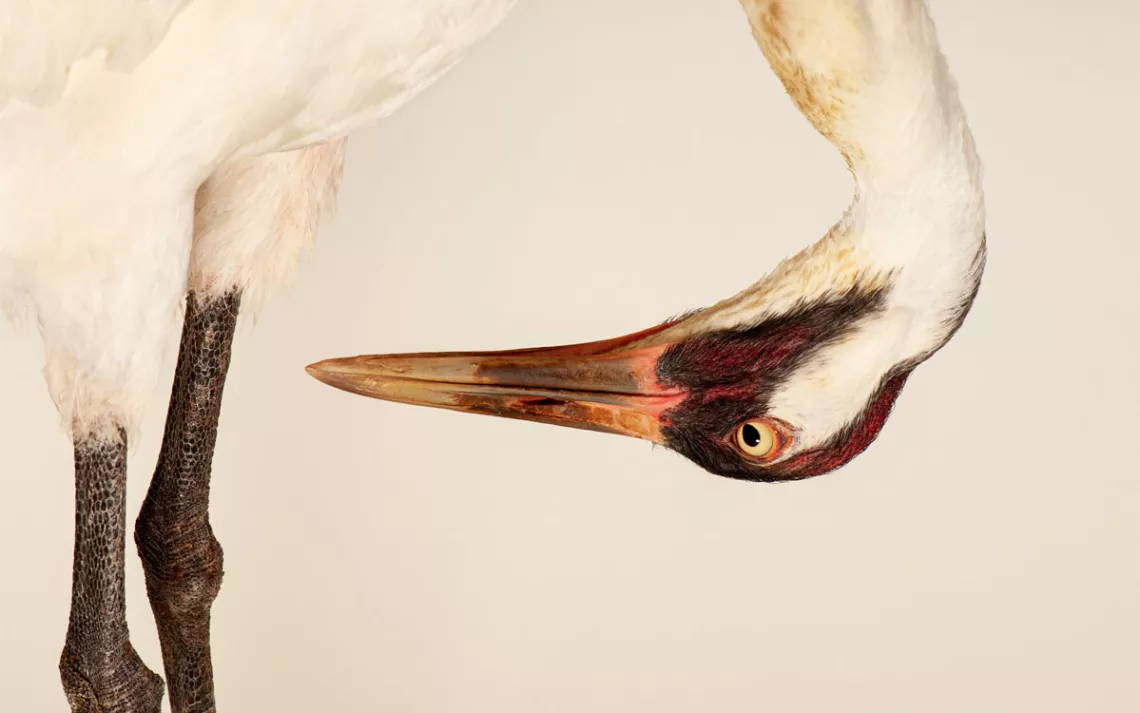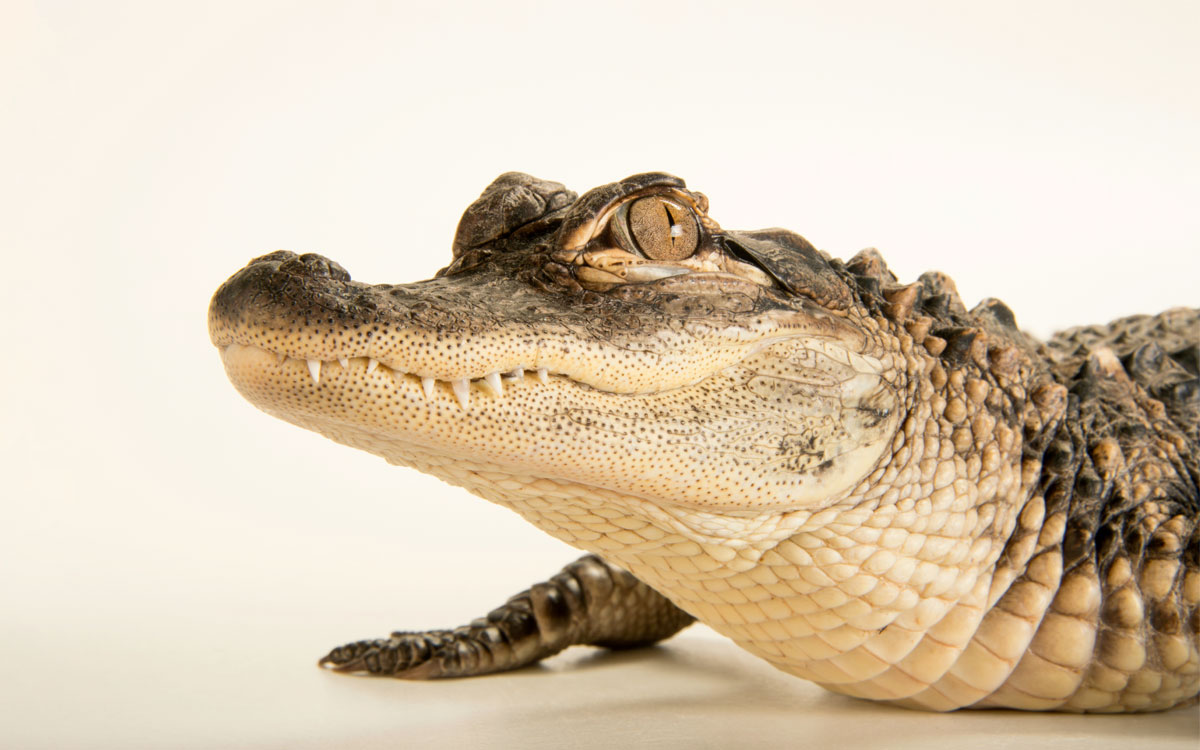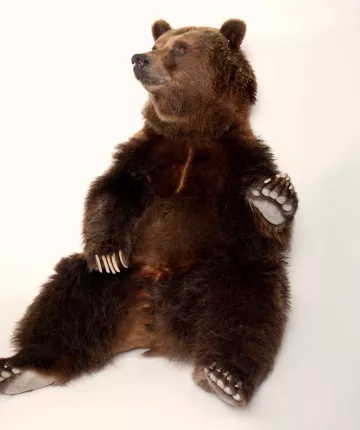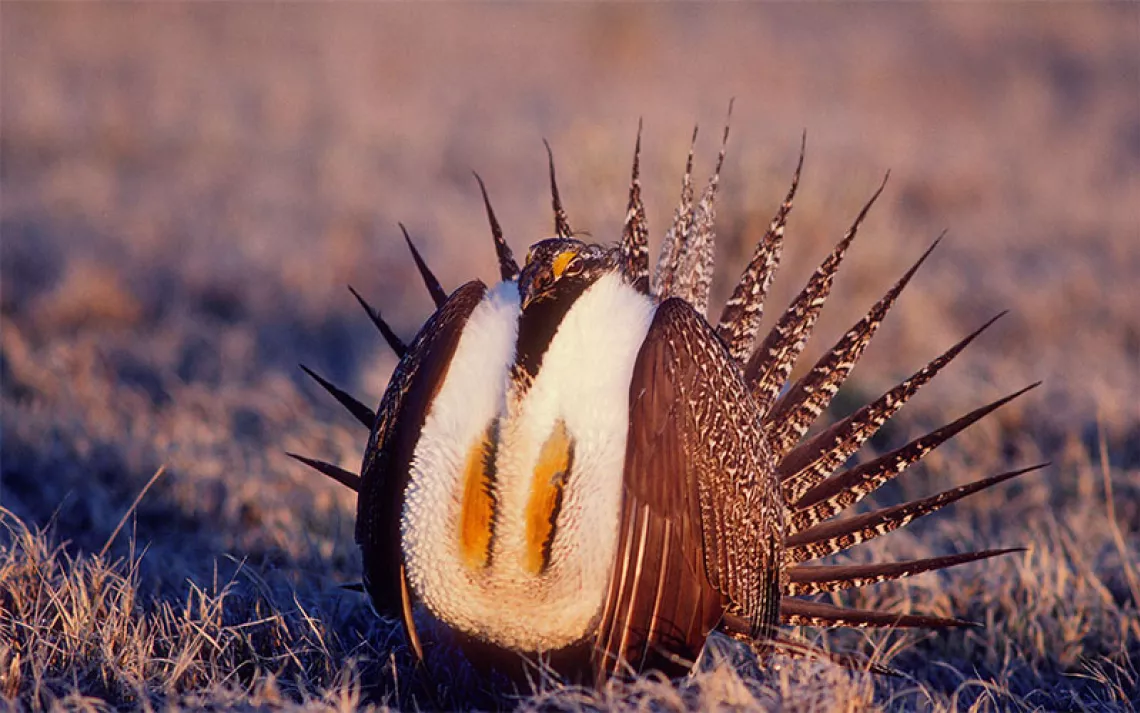Celebrating America’s Greatest Wildlife Conservation Law
A tribute to the Endangered Species Act on its 50th anniversary

Thanks to the ESA, the population of North American whooping cranes has increased from a mere 15 to more than 500.
ON A JUNE MORNING in 1976, as dawn painted a pastel ending to the short New Jersey night, I sat in my camper van outside Island Beach State Park, waiting for the arrival of a cardboard box. Two people I expected but had never met pulled up. When they opened the box, three peregrine falcon chicks glared at me with a look of fear and defiance combined. Hatched at the Peregrine Fund's facility at the Cornell Lab of Ornithology, the chicks were part of an effort to save a species nearly wiped off the map by pesticides. As a 21-year-old intern, I was tasked with caring for the young falcons for a few weeks at a specially built artificial nest tower and then releasing them to fly freely into a future that was still very uncertain. We did not know whether the project would succeed. All we had was hope and the Endangered Species Act, a law that itself had been hatched just three years previously.

Once presumed extinct, the black-footed ferret has returned to the wild through captive-breeding and reintroduction programs under the ESA.
The act did not come about suddenly. Rachel Carson's 1962 book, Silent Spring, catalyzed a new environmental awareness, leading to a surge of legislation in the late 1960s. New statutes addressed air, land, and water pollution; toxic chemicals; recycling; the wildlife trade; and fisheries. The Endangered Species Preservation Act of 1966 offered the US Department of the Interior a broad directive to preserve species yet lacked explicit protections. The Endangered Species Conservation Act of 1969 expanded protection to invertebrate animals, banned importing endangered species from outside the United States, protected eight species of great whales, and set the stage for the Convention on International Trade in Endangered Species (a.k.a. CITES, the crucial law that now regulates the trade in ivory, shark fins, rhino horns, and many other species' parts and products). But the law did nothing for plants, and it did nothing to conserve the habitats of endangered species or restrict people from killing them. The Endangered Species Act of 1973 provided the explicit mandates and muscle that now protect all kinds of species and their habitats, prevent intentional harm, and require recovery plans. This is the ESA that we celebrate, and sometimes fight about, today.
Extinction was considered impossible on theological grounds until roughly 1800. Before then, most Western societies thought the world existed in a stagnant state that began when God created Earth. The thinking was that God made what is, and Creation was immutable. The discovery of mastodon skeletons by Georges Cuvier in the late 18th century shattered that worldview. Now we are all too familiar with the precariousness of a species' existence. We know that as humans usurp and toxify the world, many species are on the verge of fading into history.
Before the ESA, a population in the billions was not enough to save the most abundant bird in the western hemisphere, the passenger pigeon, from profligate slaughter. The world's last known passenger pigeon, a 29-year-old bird named Martha, died in the Cincinnati Zoo at 1 p.m. on September 1, 1914. The colorful Carolina parakeet is likewise gone. The Eskimo curlew, whose migrating flocks billowed like smoke over the Great Plains, was demolished when its migratory stopovers were converted for agricultural use and gunners shot down wagonloads of the birds for the food markets of growing cities. Decades of slaughter—part of the calculated genocide against the continent's Indigenous people—reduced 60 million wild bison to two dozen. Have you even heard of the sea mink? Gone and forgotten.

American alligators were declared recovered 20 years after being listed as endangered. Today, an estimated 5 million gators live in the southeastern United States.
For many species, the ESA has been a lifesaver. Within 125 years of first contact with European settlers, grizzly bears fell from an estimated 50,000 in 18 states to fewer than 800 living on 2 percent of their former range. An ESA-facilitated federal grizzly bear recovery plan has, in the past 30 years, defended grizzlies against proposals to increase hunting. Today about 2,000 grizzlies live in the Lower 48. Black-footed ferrets reappeared twice after being presumed extinct. Captive-breeding programs eventually built free-living populations totaling several hundred in two dozen locations in the West. The number of Puerto Rican parrots went from thousands in the 1930s to 13 in 1975. There are now about 700. The Florida manatee population had sunk from tens of thousands to fewer than 1,300. Boat strikes and propeller injuries are their main menace, and ESA-prompted protective measures, such as boating speed limits in specific areas, have allowed manatee numbers to grow to over 6,000. Likewise, North America's whooping cranes, the rarest of all the world's cranes, plummeted from around 10,000 to a low of 15 adults in 1938. There are currently more than 500 whooping cranes, giving us—and them—something to dance about.
The Endangered Species Act says that to exist is important, sufficient for human care and action.
Other ESA-facilitated recoveries have been so spectacular that it's hard to imagine certain species were ever at risk. American alligators were listed as endangered in 1967 and declared recovered 20 years later. Today an estimated 5 million live across the southeastern United States. Brown pelican numbers have increased sevenfold since the 1980s owing to restrictions on DDT and other pesticides; today several hundred thousand brown pelicans patrol our coasts. Bald eagles, long suffering from shootings, habitat loss, and pesticides, roared back from a low of 400 breeding pairs south of Canada in 1963 to a soaring 71,000 nesting pairs and more than 300,000 individuals today. They've been off the endangered species list since 2007; between 2009 and 2016, the bald eagle population quadrupled. Thanks to the ESA, the national bird is in danger no more.
ONE OF THE GREAT PLEASURES of my life has been watching—and sometimes helping—the ESA succeed in saving many threatened and endangered species. Ospreys had been essentially erased from most of the East Coast when I got my high school diploma, the same year the ESA became law. Six years passed between the time I saw my first osprey, in 1970, and my second. Now it's not uncommon to spot half a dozen at once along our shores. During the 1980s, for a month each autumn, I ran a station to count and leg-band peregrine falcons. The first year, we saw six peregrines the whole season. By our final year, we saw 26 in a single day.

Today about 2,000 grizzly bears live in the Lower 48—more than twice the population in 1973, when the ESA was passed.
Among the most inspiring—and incredible—wildlife restorations I've participated in was the rescue of the California condor. One day in 1985, my PhD adviser and I rolled up to Tejon Pass for a death vigil. We had been studying seabirds on the East Coast but decided to fly across the country to try to see a California condor before they were all gone. We knew exactly how many California condors were out there somewhere: six. Only six. The giant vultures were all dying of lead poisoning acquired from bullet fragments in the carcasses of hunter-shot deer. Their disappearance from the sky was a foregone conclusion. All six were scheduled to be taken into captivity—joining three others recently captured—where they might breed with the 20 or so captive birds and forestall or reverse the species' seemingly inevitable end. As the air warmed that morning, a speck appeared in the distant sky. Then another. Those two birds were the absolute last of a freewheeling species. But they also represented this: a last chance to show that we were better than we seemed.
Captive breeding and continual intervention were necessary; extinction wasn't. The ESA made possible the California condor's continued existence and recovery, and the establishment of new populations. Condors don't mature until they're six years old and then naturally raise only one chick every two years. But it turned out condors breed well in captivity. The captive-breeding program has hatched over 1,000 condor chicks. Several hundred free-living condors turn circles over California, the Grand Canyon region, and Baja California, Mexico. The Endangered Species Act is the only reason that they still float on rising air until they vanish—only from sight, not from existence.
To date, the act has prevented 99 percent of listed species from going extinct and has recovered or down-listed over 100 species from endangered to threatened.
The same could be said for the leatherback sea turtle, which I researched for my book Voyage of the Turtle. It was this work that had me in a small plane over the ocean with Sally Murphy, South Carolina's "sea turtle coordinator," in 2003. We were counting migrating leatherbacks. In the early 1980s, an aerial survey located one every 300 miles from Cape Hatteras, North Carolina, to Key West, Florida. But three weeks before my flight, Murphy had seen as many as three per mile, for a one-day record of 190 sightings. Funding through the Endangered Species Act had helped underpin conservation efforts such as testing and mandating turtle escape devices for shrimp trawlers and protecting nesting turtles and their eggs.
Research for another book, Beyond Words, took me to Yellowstone National Park 10 years later. It was spring, and I was looking through a scope as a family of wolves trotted from a deep grove of pines down a long, snowy hillside into the wide Lamar Valley. Wolves had been extirpated from the region in the early 1900s. Without these predators, deer and elk populations had soared, creating an ecological imbalance. After gray wolves were eradicated from 95 percent of their range in the continental United States, they were one of the first species to be listed under the ESA. In the 1990s, the act facilitated a reintroduction of wolves into Yellowstone and Idaho using a rule that allows federal agencies to designate animals as experimental populations so they can be returned into suitable but unoccupied habitat. Although wolves are revered by many Native American cultures, they're reviled by most ranchers and face hatred so visceral and irrational that it feels racial. Highly politicized in America's culture wars, wolves have been put on and taken off the endangered species list in different regions. Wherever and whenever wolves lose the ESA's protection, the traps and guns come out, and wolves quickly tumble. The ESA is the only thing that can stand between wolves and a hail of bullets.
Congressional enthusiasm for the Endangered Species Act was near unanimous when it was first signed into law. But in the decades since, the ESA has created political strains—by pitting a fish the size of a paper clip (the snail darter) against a massive dam project in Tennessee (Tellico), by the act's muscle in mandating changes in shrimp nets, and by protecting spotted owls from the clearcut logging of ancient forests. Some resent the act for stopping real estate development for a butterfly here, an obscure songbird there. These disruptions to entrenched money have fueled sustained opposition. Organized efforts have prevented the act from being updated, and—no surprise—the Trump administration tried to eviscerate it by weakening habitat protections and complicating the listing process.
I myself have been critical of the Endangered Species Act—for not being stronger. The United States has a Clean Air Act and a Clean Water Act. We don't have a Threatened Air Act or a Dirty Water Act letting the air and water get dirty before action is required. That would only get us lousy air and filthy water. The Clean Water Act says that the waters of the United States must be "swimmable and fishable"—improved and maintained at a high aspirational standard. Similarly, we should have an Abundant Species Act, a law that mandates large, stable populations and ample habitat for all wild living things. Waiting for species to be in deep trouble before we recognize widespread declines—which is what the ESA does—ensures that more species will enter the extinction vortex. That's a fundamental weakness of the ESA. But the act has fundamental strengths too, and, wow, one shudders to contemplate life without that guardrail of federal law between existence and the abyss. Many Republicans have often imagined, and sought, just that. Many people fail to appreciate—or simply oppose—the equal access to existence that the act bestows on the whole web of life. The late Alaska representative Don Young said that when he'd voted for the act, "We never thought about mussels and ferns and flowers and all these subspecies."
The ESA doesn't lose sight of or judge the relative importance of birds, fish, mammals, reptiles, butterflies, bees, burying beetles, orchids, and fairy shrimp. They're all covered, as are the myriad subtle and unprepossessing species that largely run the show in the pageant of life on Earth. The ESA says that to exist is important, sufficient for human care and action. To some people, a species is not a treasure, not a miracle, not a unique branch of living history but rather an obstacle. "A fool sees not the same tree a wise man sees," wrote William Blake, the English poet and painter. "The tree which moves some to tears of joy is in the eyes of others only a green thing which stands in the way."
Opponents have come close to severely weakening the ESA. Congress can write species out of the law, as it did with the snail darter, or exclude a specific population, as it did in 2011 when it exempted wolves in the Northern Rockies from ESA protection—the most glaring example of Congress intervening in the law. The entire Endangered Species Act—like other efforts to speak up for the voiceless and powerless—is now itself threatened. Lawsuits claiming that the ESA is unconstitutional have been considered by several federal judicial circuits. At each challenge, the constitutionality of the act has been upheld, but each court has given different reasons. Michael Bean, often referred to as "the dean of wildlife law," sees this as "worrisome." Worrisome indeed, in light of the Supreme Court's various recent decisions to strike down Clean Air Act regulations and major portions of the Voting Rights Act, the Violence Against Women Act, and affirmative action policies as well as to reverse decades of Roe v. Wade rulings. One thing that keeps me up at night is that we could be one bad Supreme Court decision away from the ESA being shredded.
Contrary to popular belief, the Endangered Species Act prohibits very little development. Still, safeguards are necessary to bolster recovery efforts. When a species is listed under the ESA, federal agencies must determine if there are areas that are essential to the species' recovery, and if so, designate those areas as critical habitat. Prohibitions against the destruction and adverse modification of that habitat are instrumental in saving the species from extinction. Our generally devastating economy has grown devastatingly, and at the same time, we've prevented a few species from getting entirely steamrolled in that process. The ESA is not the rigid law that some insist it is but rather a statement of national intent—that the United States is too great and too generous to allow the loss of its living legacy—with tremendous flexibility in how that intent is fulfilled. Creativity can be key, and conservationists are increasingly creative. Though not in the act's language, innovations such as conservation banking and safe harbor agreements, which help private landowners contribute to endangered species conservation, have come into the toolbox to facilitate recovery.
Such innovation is needed now more than ever. Worldwide, whole taxonomic groups are in trouble. More than 1,450 bird species—one in eight—are threatened, with 223 classified as critically endangered. Nineteen bird species were lost in the last quarter of the 20th century. Also consider sharks (a quarter of species considered to be between vulnerable and critically endangered), corals (declining since 2010), orchids (among the most threatened plant groups), freshwater mussels (over 200 of North America's 300 species are endangered), and the insect apocalypse. Without ESA protections and funding, the ferret and the condor and the whooping crane would be history. There would be no wolves or grizzlies south of Canada. None of the 30-plus national wildlife refuges established specifically to protect endangered species would exist. Crimes against manatees would occur with impunity, and bald eagles, peregrine falcons, and ospreys would likely be memories.
Today hundreds of plants, insects, arachnids, bivalves, corals, and snails are listed under the ESA. The endangerment of these smaller, subtler lives—so poorly positioned for pulling the strings of human sympathy and action—indicates a deeper fraying of the world's living fabrics. And generally, the smaller the organism, the less likely it will benefit from recovery trends.
I ONCE BELIEVED I would never see the little bird known as the Kirtland's warbler. But in May 2023, I found myself in Michigan, driving down a dirt road with a few people convened by the American Bird Conservancy. On one side stood a large expanse of young jack pines. The organization's senior conservation specialist, Dave Ewert, explained that the birds require hundreds of acres of young jack pines for nesting. In old times, lightning strikes burned tracts that would then sprout jack pine saplings. Indeed, the warbler had adapted to the region's natural fire-shaped ecology. But in a world as human-altered as ours, leaving things alone is not always enough. Nowadays, Ewert said, Kirtland's warblers depend on prescribed burns and replanting to maintain the hundreds of acres of young trees.
Ewert told us that the Endangered Species Act saved the Kirtland's from extinction. Land management facilitated by the ESA secured its breeding habitat in Michigan. "Kirtland's warblers have become a source of pride in Michigan and where they winter in the Bahamas as a result of the ESA," he said. By 2019, the Kirtland's warbler had recovered sufficiently to get off the list.
We stopped the car and got out. Ewert pointed and said, "I hear one singing. Listen." Yes, and more than one. A little patience got us several good sightings. I even got a good photo.
But do we truly need Kirtland's warblers? Whales? Sea turtles? It's true that the vast web of biodiversity underpins the basic elements of human civilization. We need wildlife to pollinate our food, to eat the pests that threaten our crops, and to aerate soils that filter our water. But the question of "need" is backward. We don't need them. They need us. It's not a practical matter for us. For them, it is a matter of utmost existential practicality. For us, it's moral. The past half century has shown that people and businesses can thrive alongside the Endangered Species Act, but eagles and bears and butterflies and rare orchids can't survive without it. So hooray for the USA and its ESA. To date, the act has prevented 99 percent of listed species from going extinct and has recovered or down-listed over 100 species from endangered to threatened.
The Endangered Species Act isn't just a law. It is evidence of a great nation at its most thoughtful, most generous, most farsighted, most determined to consider coming generations of humans and all the other passengers of this precious ark. The ESA is predicated on the valuation that every life-form is, in a loaded word, sacred. The US shall work to keep the ark afloat. But if the voyage is to continue, you and I must insist that species in trouble be extended the kind of action that preserved the peregrine falcon, condor, leatherback sea turtle, gray wolf, gray whale, and dozens of others that would by now have been swept out of existence. What a sad and lonely and unbeautiful existence we would lead if we let such miraculous life-forms and time-proven ancient lineages dwindle to oblivion from the shriveling face of planet Earth. Within this context, saving species gives us the opportunity to save ourselves from ruin. From this perspective, it's clear that we really do need them.
 The Magazine of The Sierra Club
The Magazine of The Sierra Club



